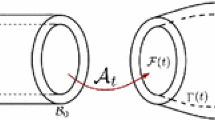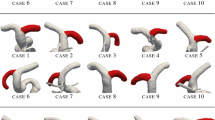Abstract
Cerebral vasospasm is a poorly understood clinical condition that appears to result from complex biochemical and biomechanical processes that manifest as yet another example of vascular growth and remodeling. We submit that mathematical modeling holds great promise to help synthesize diverse types of data and thereby to increase our understanding of vasospasm. Toward this ultimate goal, we present constitutive relations and parametric studies that illustrate the potential utility of a new theoretical framework that combines information on wall mechanics, hemodynamics, and chemical kinetics. In particular, we show that chemical and mechanical mediators of cellular and extracellular matrix turnover can differentially dominate the progression and resolution of vasospasm. Moreover, based on our simulations, endothelial damage can significantly alter the time-course and extent of vasospasm as can impairment of autoregulation. Although the present results are consistent with salient features of clinically reported vasospasm, and thus provide some new insight, we suggest that most importantly they reveal areas of pressing need with regard to the collection of additional experimental data. Without appropriate data, our understanding of cerebral vasospasm will remain incomplete.










Similar content being viewed by others
Notes
It is well known that both mechanical (mechanotransduction) and chemical (e.g., via growth factors and cytokines) stimulation alters production rates, but functional forms for synergistic vs. competitive effects remain to be determined.
References
Baek S., Rajagopal K. R., Humphrey J. D. (2006) A theoretical model of enlarging intracranial fusiform aneurysms. J. Biomech. Eng. 128(1):142–149
Bai N., Moien-Afshari F., Washio H., Min A., Laher I. (2004) Pharmacology of the mouse-isolated cerebral artery. Vascul. Pharmacol. 41(3):97–106
Bai T. R., Bates J. H. T., Brusasco V., Camoretti-Mercado B., Chitano P., Deng L. H., Dowell M., Fabry B., Ford L. E., Fredberg J. J., Gerthoffer W. T., Gilbert S. H., Gunst S. J., Hai C., Halayko A. J., Hirst S. J., James A. L., Janssen L. J., Jones K. A., King G. G., Lakser O. J., Lambert R. K., Lauzon A., Lutchen K. R., Maksym G. N., Meiss R. A., Mijailovich S. M., Mitchell H. W., Mitchell R. W., Mitzner W., Murphy T. M., Pare P. D., Schellenberg R. R., Seow C. Y., Sieck G. C., Smith P. G., Smolensky A. V., Solway J., Stephens N. L., Stewart A. G., Tang D. D., Wang L. (2004) On the terminology for describing the length–force relationship and its changes in airway smooth muscle. J. Appl. Physiol. 97(6):2029–2034
Chuong C. J., Fung Y. C. (1983) Three-dimensional stress distribution in arteries. J. Biomech. Eng. 105(3):268–274
Chuong C. J., Fung Y. C. (1984) Compressibility and constitutive equation of arterial wall in radial compression experiments. J. Biomech. 17(1):35–40
Chuong C. J., Fung Y. C. (1986) On residual stresses in arteries. J. Biomech. Eng. 108(2):189–192
Clower B. R., Yamamoto Y., Cain L., Haines D. E., Smith R. R. (1994) Endothelial injury following experimental subarachnoid hemorrhage in rats: effects on brain blood flow. Anat. Rec. 240(1):104–114
Dorrington K. L., Mccrum N. G. (1977) Elastin as a rubber. Biopolymers 16:1201–1222
Farrar J. K. (1975) Chronic cerebral arterial spasm. The role of intracranial pressure. J. Neurosurg. 43(4):408–417
Fung, Y. C. Biomechanics: Motion, Flow, Stress, and Growth. Springer, 1990
Gleason R. L., Humphrey J. D. (2004) A mixture model of arterial growth and remodeling in hypertension: altered muscle tone and tissue turnover. J. Vasc. Res. 41:352–363
Gleason R. L., Taber L. A., Humphrey J. D. (2004) A 2-d model of flow-induced alterations in the geometry, structure, and properties of carotid arteries. J. Biomech. Eng. 126:371–381
Handa Y., Hayashi M., Takeuchi H., Kubota T., Kobayashi H., Kawano H. (1992) Time course of the impairment of cerebral autoregulation during chronic cerebral vasospasm after subarachnoid hemorrhage in primates. J. Neurosurg. 76:493–501
Holzapfel G. A., Gasser T. C., Ogden R. W. (2000) A new constitutive framework for arterial wall mechanics and a comparative study of material models. J. Elasticity 61(1–3):1–48
Hu, J. J., S. Baek, and J. D. Humphrey. Stress–strain behavior of the passive basilar artery in normotension and hypertension. J. Biomech. (in press)
Humphrey, J. D., S. Baek, and L. E. Niklason. Biochemomechanics of cerebral vasospasm and its resolution: I. A new hypothesis and theoretical framework. Ann. Biomed. Eng. doi:10.1007/s10439-007-9321-y.
Ishiguro M., Puryear C. B., Bisson E., Saundry C. M., Nathan D. J., Russell S. R., Tranmer B. I., Wellman G. C. (2002) Enhanced myogenic tone in cerebral arteries from a rabbit model of subarachnoid hemorrhage. Am. J. Physiol. Heart Circ. Physiol. 283:H2217–H2225
Johshita H., Kassell N. F., Sasaki T., Nakagomi T., Ogawa H. (1992) Biphasic constriction of rabbit basilar artery following experimental subarachnoid hemorrhage: a morphometric study. Surg. Neurol. 37(2):106–114
Langille, B. L. (1993) Remodeling of developing and mature arteries: endothelium, smooth muscle, and matrix. J. Cardiovasc. Pharmacol. 21:S11–S17
Langille B. L., Bendeck M. P., Keeley F. W. (1989) Adaptations of carotid arteries of young and mature rabbits to reduced carotid blood flow. Am. J. Physiol. 256:H931–H939
Lanir Y. (1983) Constitutive equations for fibrous connective tissues. J. Biomech. 16(1):1–12
Lodi C. A., Ursino M. (1999) Hemodynamic effect of cerebral vasospasm in humans: a modeling study. Ann. Biomed. Eng. 27:257–273
Macdonald R. L., Weir B. (2001) Cerebral Vasospasm. Academic Press, San Diego
Mayberg M. R., Okada T., Bark D. H. (1990) Morphologic changes in cerebral arteries after subarachnoid hemorrhage. Neurosurg. Clin. N. Am. 1(2):417–32
Meurice T., Vallet B., Bauters C., Dupuis B., Lablanche J. M., Bertrand M. E. (1996) Role of endothelial cells in restenosis after coronary angioplasty. Fundam. Clin. Pharmacol. 10(3):234–242
Nabavi D. G., LeBlanc L. M., Baxter B., Lee D. H., Fox A. J., Lownie S. P., Ferguson G. G., Craen R. A., Gelb A. W., Lee T. Y. (2001) Monitoring cerebral perfusion after subarachnoid hemorrhage using CT. Neuroradiology 43:7–16
Nagasawa S., Handa H., Okumura A., Naruo Y., Moritake K., Hayashi K. (1979) Mechanical properties of human cerebral arteries. Part 1: Effects of age and vascular smooth muscle activation. Surg. Neurol. 12(4):297–304
Nagasawa S., Handa H., Okumura A., Naruo Y., Okamoto S., Moritake K., Hayashi K. (1980) Mechanical properties of human cerebral arteries: part 2. Vasospasm. Surg. Neurol. 14:285–290
Naghshin J., Wang L., Pare P. D., Seow C. Y. (2003) Adaptation to chronic length change in explanted airway smooth muscle. J. Appl. Physiol. 95(1):448–453
Nissen R., Cardinale G. J., Udenfriend S. (1978) Increased turnover of arterial collagen in hypertensive rates. Proc. Natl. Acad. Sci. USA 75:451–453
Rachev A., Hayashi K. (1999) Theoretical study of the effects of vascular smooth muscle contraction on strain and stress distributions in arteries. Ann. Biomed. Eng. 27:459–468
Rachev A., Stergiopulos N., Meister J. J. (1998) A model for geometric and mechanical adaptation of arteries to sustained hypertension. ASME J. Biomech. Eng. 120(1):9–17
Rätsep T., Asser T. (2001) Cerebral hemodynamic impairment after aneurysmal subarachnoid hemorrhage as evaluated using transcranial Doppler ultrasonography: relationship to delayed cerebral ischemia and clinical outcome. J. Neurosurg. 95:393–401
Strauss B. H., Chisholm R. J., Keeley F. W., Gotlieb A. I., Logan R. A., Armstrong P. W. (1994) Extracellular matrix remodeling after balloon angioplasty injury in a rabbit model of restenosis. Circ. Res. 75(4):650–658
Strauss B. H., Robinson R., Batchelor W. B., Chisholm R. J., Ravi G., Natarajan M. K., Logan R. A., Mehta S. R., Levy D. E., Ezrin A. M., Keeley F. W. (1996) In vivo collagen turnover following experimental balloon angioplasty injury and the role of matrix metalloproteinases. Circ. Res. 79(3):541–550
Taber L. A. (1998) A model for aortic growth based on fluid shear stresses and fiber stresses. ASME J. Biomech. Eng. 120:348–354
Valentín, A., and J. D. Humphrey. On time-courses of cell and matrix turnover in arterial growth and remodeling. Submitted for publication.
Walmsley J. G., Campling M. R., Chertkow H. M. (1983) Interrelationships among wall structure, smooth muscle orientation, and contraction in human major cerebral arteries. Stroke 14:781–790
Yamaguchi-Okada M., Nishizawa S., Koide M., Nonaka Y. (2005) Biomechanical and phenotypic changes in the vasospastic canine basilar artery after subarachnoid hemorrhage. J. Appl. Physiol. 99(5):2045–2052
Yundt K. D., Grubb R. L., Diringer M. N., Powers W. J. (1998) Autoregulatory vasodilation of parenchymal vessels is impaired during cerebral vasospasm. J. Cerebral Blood Flow Metabol. 18:419–424
Zeller P. J., Skalak T. C. (1998) Contribution of individual structural components in determining the zero-stress state in small arteries. J. Vasc. Res. 35(1):8–17
Zulliger M. A., Rachev R., Stergiopulos N. (1987) A constitutive formulation of arterial mechanics including vascular smooth muscle tone. J. Vasc. Surg. 5:413–420
Acknowledgment
This research was supported, in part, by NIH grants HL-80415 and HL-64372 (through the BRP Program).
Author information
Authors and Affiliations
Additional information
Address correspondence to J. D. Humphrey, Department of Biomedical Engineering, Texas A&M University, 337 Zachry Engineering Center, 3120 TAMU, College Station, TX 77843-3120, USA. Electronic mail: jhumphrey@tamu.edu
Rights and permissions
About this article
Cite this article
Baek, S., Valentín, A. & Humphrey, J.D. Biochemomechanics of Cerebral Vasospasm and its Resolution: II. Constitutive Relations and Model Simulations. Ann Biomed Eng 35, 1498–1509 (2007). https://doi.org/10.1007/s10439-007-9322-x
Received:
Accepted:
Published:
Issue Date:
DOI: https://doi.org/10.1007/s10439-007-9322-x




